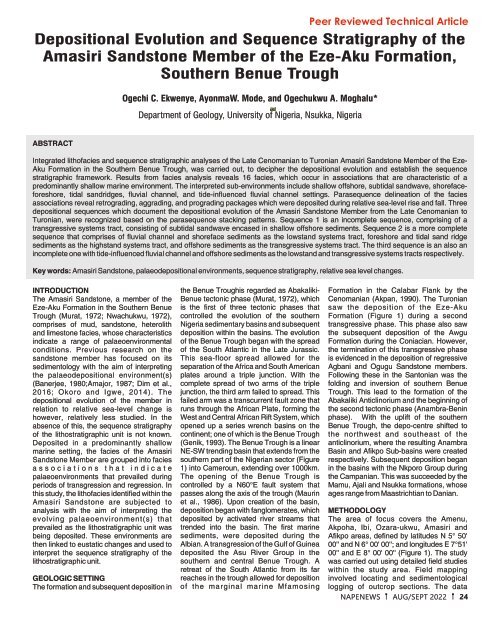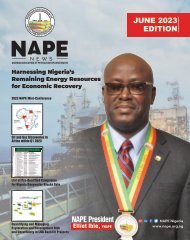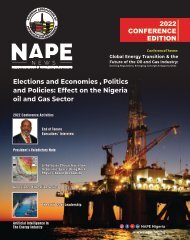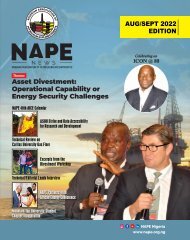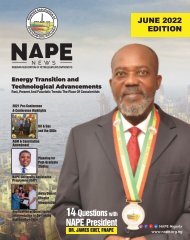Create successful ePaper yourself
Turn your PDF publications into a flip-book with our unique Google optimized e-Paper software.
Depositional Evolution and Sequence Stratigraphy of the<br />
Amasiri Sandstone Member of the Eze-Aku Formation,<br />
Southern Benue Trough<br />
Ogechi C. Ekwenye, AyonmaW. Mode, and Ogechukwu A. Moghalu*<br />
Department of Geology, University of Nigeria, Nsukka, Nigeria<br />
Peer Reviewed Technical Article<br />
ABSTRACT<br />
Integrated lithofacies and sequence stratigraphic analyses of the Late Cenomanian to Turonian Amasiri Sandstone Member of the Eze-<br />
Aku Formation in the Southern Benue Trough, was carried out, to decipher the depositional evolution and establish the sequence<br />
stratigraphic framework. Results from facies analysis reveals 16 facies, which occur in associations that are characteristic of a<br />
predominantly shallow marine environment. The interpreted sub-environments include shallow offshore, subtidal sandwave, shorefaceforeshore,<br />
tidal sandridges, fluvial channel, and tide-influenced fluvial channel settings. Parasequence delineation of the facies<br />
associations reveal retrograding, aggrading, and prograding packages which were deposited during relative sea-level rise and fall. Three<br />
depositional sequences which document the depositional evolution of the Amasiri Sandstone Member from the Late Cenomanian to<br />
Turonian, were recognized based on the parasequence stacking patterns. Sequence 1 is an incomplete sequence, comprising of a<br />
transgressive systems tract, consisting of subtidal sandwave encased in shallow offshore sediments. Sequence 2 is a more complete<br />
sequence that comprises of fluvial channel and shoreface sediments as the lowstand systems tract, foreshore and tidal sand ridge<br />
sediments as the highstand systems tract, and offshore sediments as the transgressive systems tract. The third sequence is an also an<br />
incomplete one with tide-influenced fluvial channel and offshore sediments as the lowstand and transgressive systems tracts respectively.<br />
Key words: Amasiri Sandstone, palaeodepositional environments, sequence stratigraphy, relative sea level changes.<br />
INTRODUCTION<br />
The Amasiri Sandstone, a member of the<br />
Eze-Aku Formation in the Southern Benue<br />
Trough (Murat, 1972; Nwachukwu, 1972),<br />
comprises of mud, sandstone, heterolith<br />
and limestone facies, whose characteristics<br />
indicate a range of palaeoenvironmental<br />
conditions. Previous research on the<br />
sandstone member has focused on its<br />
sedimentology with the aim of interpreting<br />
the palaeodepositional environment(s)<br />
(Banerjee, 1980;Amajor, 1987; Dim et al.,<br />
2016; Okoro and Igwe, 2014). The<br />
depositional evolution of the member in<br />
relation to relative sea-level change is<br />
however, relatively less studied. In the<br />
absence of this, the sequence stratigraphy<br />
of the lithostratigraphic unit is not known.<br />
Deposited in a predominantly shallow<br />
marine setting, the facies of the Amasiri<br />
Sandstone Member are grouped into facies<br />
a s s o c i a t i o n s t h a t i n d i c a t e<br />
palaeoenvironments that prevailed during<br />
periods of transgression and regression. In<br />
this study, the lithofacies identified within the<br />
Amasiri Sandstone are subjected to<br />
analysis with the aim of interpreting the<br />
evolving palaeoenvironment(s) that<br />
prevailed as the lithostratigraphic unit was<br />
being deposited. These environments are<br />
then linked to eustatic changes and used to<br />
interpret the sequence stratigraphy of the<br />
lithostratigraphic unit.<br />
GEOLOGIC SETTING<br />
The formation and subsequent deposition in<br />
the Benue Troughis regarded as Abakaliki-<br />
Benue tectonic phase (Murat, 1972), which<br />
is the first of three tectonic phases that<br />
controlled the evolution of the southern<br />
Nigeria sedimentary basins and subsequent<br />
deposition within the basins. The evolution<br />
of the Benue Trough began with the spread<br />
of the South Atlantic in the Late Jurassic.<br />
This sea-floor spread allowed for the<br />
separation of the Africa and South American<br />
plates around a triple junction. With the<br />
complete spread of two arms of the triple<br />
junction, the third arm failed to spread. This<br />
failed arm was a transcurrent fault zone that<br />
runs through the African Plate, forming the<br />
West and Central African Rift System, which<br />
opened up a series wrench basins on the<br />
continent; one of which is the Benue Trough<br />
(Genik, 1993). The Benue Trough is a linear<br />
NE-SW trending basin that extends from the<br />
southern part of the Nigerian sector (Figure<br />
1) into Cameroun, extending over 1000km.<br />
The opening of the Benue Trough is<br />
controlled by a N60°E fault system that<br />
passes along the axis of the trough (Maurin<br />
et al., 1986). Upon creation of the basin,<br />
deposition began with fanglomerates, which<br />
deposited by activated river streams that<br />
trended into the basin. The first marine<br />
sediments, were deposited during the<br />
Albian. A transgression of the Gulf of Guinea<br />
deposited the Asu River Group in the<br />
southern and central Benue Trough. A<br />
retreat of the South Atlantic from its far<br />
reaches in the trough allowed for deposition<br />
of the marginal marine Mfamosing<br />
Formation in the Calabar Flank by the<br />
Cenomanian (Akpan, 1990). The Turonian<br />
saw the deposition of the Eze-Aku<br />
Formation (Figure 1) during a second<br />
transgressive phase. This phase also saw<br />
the subsequent deposition of the Awgu<br />
Formation during the Coniacian. However,<br />
the termination of this transgressive phase<br />
is evidenced in the deposition of regressive<br />
Agbani and Ogugu Sandstone members.<br />
Following these in the Santonian was the<br />
folding and inversion of southern Benue<br />
Trough. This lead to the formation of the<br />
Abakaliki Anticlinorium and the beginning of<br />
the second tectonic phase (Anambra-Benin<br />
phase). With the uplift of the southern<br />
Benue Trough, the depo-centre shifted to<br />
the northwest and southeast of the<br />
anticlinorium, where the resulting Anambra<br />
Basin and Afikpo Sub-basins were created<br />
respectively. Subsequent deposition began<br />
in the basins with the Nkporo Group during<br />
the Campanian. This was succeeded by the<br />
Mamu, Ajali and Nsukka formations, whose<br />
ages range from Maastrichtian to Danian.<br />
METHODOLOGY<br />
The area of focus covers the Amenu,<br />
Akpoha, Ibi, Ozara-ukwu, Amasiri and<br />
Afikpo areas, defined by latitudes N 5° 50'<br />
00'' and N 6° 00' 00''; and longitudes E 7°51'<br />
00'' and E 8° 00' 00'' (Figure 1). The study<br />
was carried out using detailed field studies<br />
within the study area. Field mapping<br />
involved locating and sedimentological<br />
logging of outcrop sections. The data<br />
NAPENEWS AUG/SEPT <strong>2022</strong> 24


